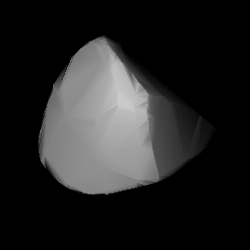 Shape model of Valyaev from its lightcurve | |
| Discovery [1] | |
|---|---|
| Discovered by | T. Smirnova |
| Discovery site | Crimean Astrophysical Obs. |
| Discovery date | 8 February 1967 |
| Designations | |
| (3962) Valyaev | |
Named after | Valerij Valyaev (Russian astronomer) [2] |
| 1967 CC ·1973 GL1 1976 UT10 ·1982 XE1 1984 DC2 | |
| main-belt · Themis [3] | |
| Orbital characteristics [1] | |
| Epoch 4 September 2017 (JD 2458000.5) | |
| Uncertainty parameter 0 | |
| Observation arc | 60.92 yr (22,251 days) |
| Aphelion | 3.5778 AU |
| Perihelion | 2.8406 AU |
| 3.2092 AU | |
| Eccentricity | 0.1148 |
| 5.75 yr (2,100 days) | |
| 293.47° | |
| 0° 10m 17.04s / day | |
| Inclination | 1.9984° |
| 49.683° | |
| 106.16° | |
| Physical characteristics | |
| 14.76±1.11 km [4] 16.285±0.231 km [5] [6] | |
| 16.4399±0.0077 h [3] [7] | |
| 0.08 (assumed) [3] 0.088±0.014 [5] [6] 0.089±0.014 [4] | |
| C (assumed) [3] | |
| 12.2 [5] ·12.4 [1] [4] ·12.403±0.005(R) [7] ·12.56±0.19 [8] ·12.85 [3] | |
3962 Valyaev (prov. designation: 1967 CC) is a dark Themistian asteroid from the outer region of the asteroid belt. The presumed C-type asteroid has a rotation period of 16.4 hours and measures approximately 15 kilometers (9.3 miles) in diameter. It was discovered on 8 February 1967, by Russian astronomer Tamara Smirnova at Nauchnyj on the Crimean peninsula, and later named after Russian astronomer Valerij Valyaev. [2] [9]